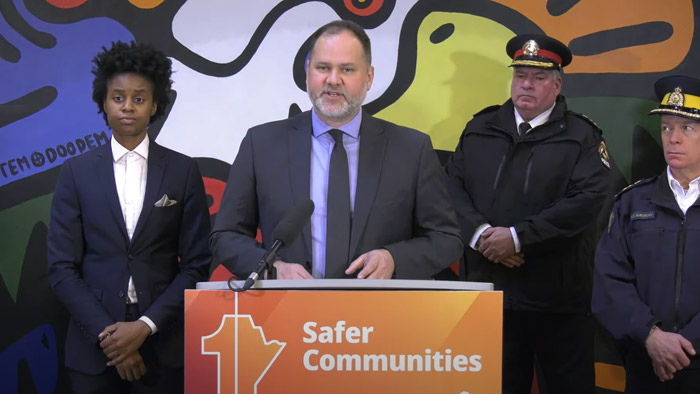Justice Minister Matt Wiebe announced that the Manitoba government has unveiled the new Safer Neighbourhoods, Safer Downtowns Public Safety Strategy, creating a roadmap for a safer Manitoba across all regions.
“Manitobans know that to see real change we must address crime and the causes of crime,” said Wiebe. “That’s what this strategy is all about. Right now, we have the chance to turn things around for the better. This strategy is just the beginning, to provide a new path forward for everyone in Manitoba to feel safe.”
The strategy addresses violent crime and retail theft, and the roots and causes of crime, the minister noted. The strategy also recognizes the need to invest in communities through community-led justice, reconciliation and ending violence against women and girls.
The minister noted the plan outlines a number of initiatives aimed at keeping Manitobans safe including:
- making the Retail Crime Initiative permanent by funding 12 new Winnipeg Police Service officers committed to community policing;
- investing in safer communities through a two per cent increase in funding for municipal law enforcement, providing stable and consistent funding for more boots on the ground;
- establishing a new Centre for Justice in Dauphin that includes culturally appropriate supports, educational resources and vocational training;
- strengthening Manitoba’s impaired driving legislation with input from Mothers Against Drunk Driving (MADD);
- expanding the electronic monitoring program outside of Winnipeg and enhancing protection order enforcement in rural areas;
- increasing funding and training opportunities for First Nations police officers and First Nation safety officer programs;
- hiring 100 new mental health workers to work alongside first responders to strengthen mental health supports for both adults and youth, starting with 25 workers by the end of March; and
- holding a youth summit to bring young leaders together to hear their voices, empower them and discuss solutions.
“We believe in creating pathways to success rather than pipelines to prison by empowering and supporting our youth and preventing people leaving prison from reoffending,” said Wiebe. “The justice system shouldn’t be the end of the road for Manitobans. It should be the beginning of accountability and real change. We’re committed to ensuring our justice system provides support for those Manitobans who are ready to turn their lives around, find meaningful work and give back to their communities.”
The Safer Neighbourhoods, Safer Downtowns Public Safety Strategy was crafted after extensive consultations with stakeholders including a public safety summit which had representatives from 210 community groups, social service agencies, health-care professionals, law enforcement agencies, Indigenous organizations, legal professionals, business leaders and government officials. The Manitoba government also held regional consultation sessions and engaged with nine First Nations governments and organizations including the Manitoba Métis Federation, Inuit organizations and other community partners.
“On behalf of the Manitoba Keewatinowi Okimakanak and the 26 First Nations we represent, I commend the Province of Manitoba for the ongoing dialogue with our organization regarding the Public Safety Strategy,” said Grand Chief Garrison Settee, Manitoba Keewatinowi Okimakanak. “This report marks the beginning of what we hope will result in safer communities for our citizens in the north and for all Manitobans. While this is a positive first step, we must not lose sight that there is still much work to be done. This Public Safety Strategy represents true ReconciliACTION and is a framework that will continue to evolve. We can work together to create positive change. Ekosani.”
“All Manitobans deserve to feel safe in their communities,” said Kathy Valentino, interim president, the Association of Manitoba Municipalities. “The Association of Manitoba Municipalities therefore welcomes the Manitoba governments efforts in establishing a Public Safety Strategy as a critical step toward creating safer communities for all Manitobans, no matter where they live. We also thank the government for conducting provincewide consultations with our members to help inform the development of this strategy as well as committing to annual escalatory funding to support municipal law enforcement. As we move toward implementation, ongoing collaboration between the Manitoba government and municipalities will be key to ensuring safer, more secure communities across our province.”
“The Manitoba Public Safety Strategy is an important roadmap to improve the safety of communities in Manitoba,” said Deputy Chief Scot Halley, Winnipeg Police Service, and president, Manitoba Association of Chiefs of Police. “While fundamental change cannot occur overnight, this strategy should be viewed as an important first in a multistep process that will require collaboration and partnerships to effect the positive changes envisioned.”


